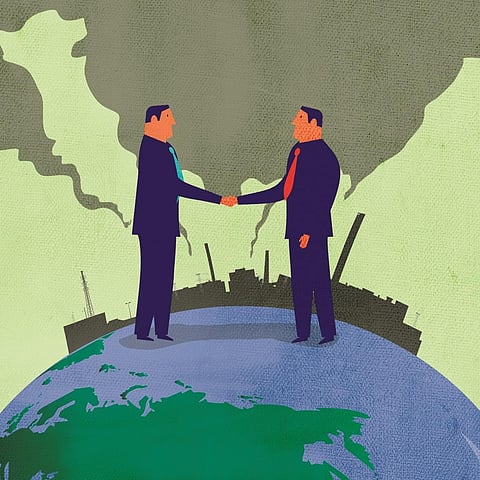A new world order taking shape
In 2024, we must rework trade rules for a different kind of globalisation. This is important both for the economies in the Global South and the fight against climate change.
Many yesterdays ago, when the world was discussing the possibility of a climate crisis, it was also negotiating a new trade agreement. In early 1990, when the UN Framework Convention on Climate Change was agreed at the Rio Summit, the World Trade Organization (WTO) was also set up and global rules to facilitate free trade between nations was signed on. The deal was simple: the cost of manufacturing would come down when goods were produced in countries with lower labour costs and environmental standards. The export-economies would drive prosperity in the still-developing world, but most importantly in the rich world where consumers would benefit from cheaper goods and the boom in services. The tectonic shift came in 2001, with the acceptance of China into WTO. China had massive workforce; no trade unions; little environmental safeguards; and an authoritarian government. After joining WTO, China’s share of global CO2 emissions rose from 5 per cent in 1990 to 21 per cent in 2019. Trade boomed but the age of global prosperity did not come, and an increased trade meant that CO2 emission increased.
In 20 years, this idea of globalisation has soured—the proponents of the grand scheme are turning their backs to the idea of unfettered global trade, which was designed to be without distortions of subsidy and support by national governments. The question is how will these new globalisation rules take shape in a climate-risked and war-torn world?
Today the most hyped issue is US’ position against China. This is being talked about as the fight against autocratic and undemocratic regimes (which is true). But the real reason is to gain control over resources and technologies needed for the future, including the green economy that the world so desperately needs. China today dominates the supply chains for batteries; it processes over half of the world’s lithium, cobalt and graphite; and it is an established leader in solar energy. To fight this “enemy”, the US has decided to give up all its ideological qualms about subsidies; the Inflation Reduction Act (IRA) is providing finance to companies to manufacture low-carbon products in the US.
The issue is if the western world’s mission to break this stranglehold will lead to higher costs of the green transition and even delay it? Or will it be successful in doing the impossible—securing access to rare minerals and rebuilding its manufacturing industry, despite the higher costs of labour and environmental standards. This could lead to de-globalisation or localisation as more countries decide to maximise their advantage as holders of natural resources, and technology and the knowledge that goes with it. It is also a possibility that there are new breakthroughs in technology, which would make the China-dominated supply chain redundant. For instance, there is talk about sodiumion batteries that could take down the need for lithium batteries.
De-globalisation could equally mean that the pace of green transition is disrupted. For instance, the US, through IRA, is providing support to local manufacturing of electric vehicles. It has notified that electric vehicles that include Chinese-made battery components will not be eligible for full subsidies. It goes on to say that these vehicles will not qualify for IRA if they have “significant” ties to the Chinese government or are produced with a licensing agreement with a China-based or -controlled operator. Given the near-complete control of China in the raw mineral and battery manufacturing segment, this disengagement may delay the electric vehicle transition or make it more expensive. The Chinese electric car manufacturer, BYD, has already overtaken Elon Musk’s Tesla. According to the Financial Times, in the fourth quarter of 2023, BYD sold a record 526,000 battery-only electric vehicles, as compared to Tesla’s 484,000. Therefore, managing the twin objectives of localisation and a speedy green transition in today’s China-dominated world could be a challenge.
It is the same in India. We have decided—and rightly so—to invest in local capacity for solar industry. The Indian government has announced fiscal incentives for solar cell and module manufacture and imposed higher import duties on Chinese products. It is difficult to say, as yet, if this will impede India’s ambitious renewable programme, as domestic production may not be able to keep pace or be cost-competitive. On the other hand, there is an obvious advantage in building our industry. The gradual closing of the free-trade world will also have implications for Indian industry’s exports. All in all, there is a new game in town and we need to see if this time around the rules of trade will work for or against the people and the Planet.
This will first be published in the 16-31 January, 2024 print edition of Down To Earth


